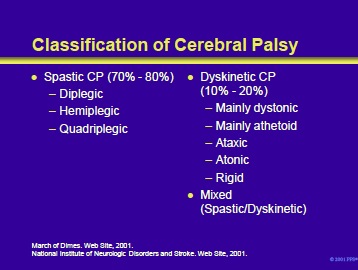
Patients with cerebral palsy can be classified by their type of abnormal tone into spastic (diplegic, hemiplegic and quadriplegic) cerebral palsy and dyskinetic (mainly dystonic or athetoid, ataxic or atonic) cerebral palsy.
The spastic type is discussed in the following slides. In patients with dyskinetic cerebral palsy, the primary site of pathology is in the striatum and the thalamus, areas with the highest concentration of glutamate receptors. Inability to synthesize or transport GABA may contribute to the clinical manifestations.
- Dystonic cerebral palsy manifests as sustained muscle contractions with resultant abnormal postures, twisting or repetitive movements. It usually begins at 3-5 years of age, changes as the brain matures and does not result in contractures.
- Athetoid cerebral palsy manifests as slow writhing movements of the distal musculature. Sixty-five percent of patients with this disorder present by the age of 2 years. Although they have a motor disorder and their postural reflexes are spared, children with athetoid cerebral palsy are intellectually spared.
Notably, spastic and dyskinetic movement disorders are frequently seen in the same patient (mixed presentation). In some instances, severe spasticity may mask the movement disorder. Therefore, the patients are defined by their predominant symptoms.
Add comment